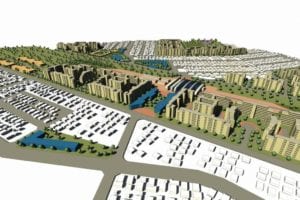Pictured: The philosophy underpinning HUB-id is the integration of economists, transport modellers, engineers, urban designers, and property professionals
International engineering, management and specialist technical consultancy Aurecon has launched new smarts and approaches to transport and land-use planning which lead to gains in economic and social sustainability for communities. “The key is to create improved interconnectedness and accessibility for communities, providing more liveable cities. We need to set new standards for quality and integration of public transport and land use,” says Brian Smith, Aurecon technical leader, and transport services. Global urbanisation has put pressure on availability of suitable land and infrastructure spending. This has generated a rethink about how the highest form of integration of transport and land use is achieved to meet short and long term objectives. “Understanding how cities flow and finding sustainable pathways between city centres and suburban developments requires an integrated approach to achieve sustainable transport and land use outcomes – something Aurecon understands well and is the basis of the HUB-id approach,” says Phil Hendricks, Aurecon industry leader transport. The HUB-id offering comprises a collection of integrated Aurecon services. “The team is already integrated and thinking the same way, so there is no need for the client to make up a team to get the same result. This approach brings savings in cost, time and reduces risk, providing excellence in client service,” adds Hendricks.Through the development of cutting edge methods, strategies and tools such as HUB-Trips, a rapid assessment tool, and AureALIS, an agent based simulation tool, Aurecon are measuring, modelling and providing advice on new metrics such as urban comfort and what makes an interchange a place.
“HUB-Trips is a graphical, interactive planning tool that can provide immediate feedback on the benefits, costs and other land use and transport attributes of options, delivering a robust basis for transit-orientated planning regardless of the urban environment,” says Smith. Global urbanisation, population growth and social trends relating to congestion and climate change have been catalysts for the reconsideration of how people, places and public transport are managed. In response to these problems, Aurecon’s HUB-id philosophy provides unique planning that links transport, land use planning and property development, to create integrated urban design for communities. “Infrastructure providers have to find a solution for intensified urbanisation while remaining sensitive to the green economy. Historically, urban sprawl has been a response, enabled through the consumption of land which is no longer a desirable option. A solution is the intensified land use around hubs and connecting those with strong public transport supply.” explains Smith. Through the use of smart assessment tools HUB-id moves away from the traditional and establishes a consolidated approach that links integrated transport planning, transit orientated development and place-making to cater for individual destination (“id”) and not only the transport mode. Through a multidisciplinary approach, the highest form of integration of transport and land use is achieved. “The philosophy underpinning HUB-id is the integration of economists, transport modellers, engineers, urban designers, and property professionals, and puts people at the centre of design considerations,” explains Hendricks. Hendricks believes making places where people are the central focus redefines best practice in transport and land use integration. Smith adds, “Aurecon’s HUB-id is based on more than conventional land-use and transport planning; it’s about understanding the economic drivers behind where, why and what, then applying fresh thinking, clever technology and approaches to smartly facilitate journey-making and creating attractive urban solutions.”







